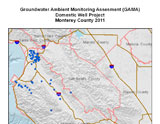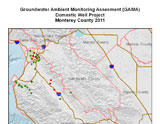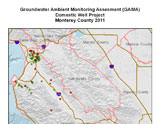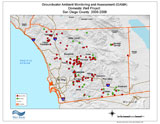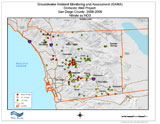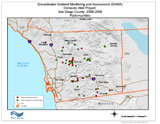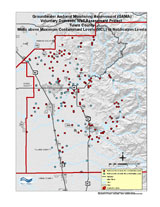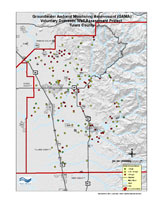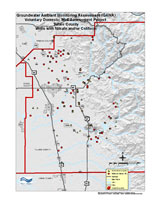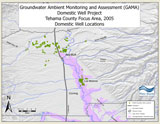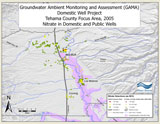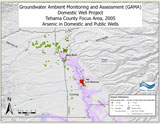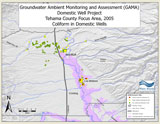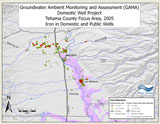
GAMA - Domestic Well Project Site
Domestic well water is for private use and consumption, typically by single family homeowners. Although its quality is not regulated by the State of California, private domestic well water is a concern, to local health and planning agencies, and to State agencies in charge of maintaining water quality.
The GAMA Domestic Well Project samples domestic wells for commonly detected chemicals, at no cost to well owners who volunteer when the project is active in their county. Results are shared with the well owners and used by the GAMA Program to evaluate the quality of groundwater used by private well owners. The Domestic Well Project has sampled six County Focus Areas in California as of 2011, and is currently on hiatus pending funding. See a listing of all Domestic Well Project Reports. Please contact GAMA if you have any questions at GAMA@waterboards.ca.gov.
Domestic Well Analytes
The GAMA Domestic Well Project tests for chemicals that are most commonly a concern in domestic well water:
- Bacteria indicators (Total and Fecal Coliform)
- General minerals and ions (sodium, bicarbonate, calcium, others)
- General chemistry parameters (pH, TDS, others)
- Inorganics (lead, arsenic and other metals) and nutrients (nitrate, others)
- Organics (benzene, toluene, PCE, MTBE, and others)
See a table summarizing analytical test methods for commonly found and selected chemicals of interest.
Additional chemicals of concern occur in some areas of California. GAMA has previously sampled for:
- Radionuclides | Perchlorate | Pesticides | Chromium VI
County Focus Areas
There have been six county focus areas sampled to date:
»» Monterey (2011) | San Diego (2008/09) | Tulare (2006) | Tehama (2005) | El Dorado (2003/04) | Yuba (2002)»» View a map of the Domestic Well Project Focus Areas
The focus areas are chosen based upon several parameters in close coordination with county agencies. The State Water Board incurs the cost of sampling and analyses.
County Focus Area Summary
The results from sampled domestic wells are compared to State Water Board Division of Drinking Water (DDW-formerly the California Department of Public Health) drinking water standards. Although the State of California does not regulate domestic well water quality, it is informative for well owners to compare their results to these standards. Results from each focus area are summarized in the table below. The table shows the total number of wells with a chemical above a drinking water standard.
The results summarized in the table above are from wells sampled as part of a voluntary program. Therefore, the results may not reflect the spatial distribution of domestic wells or noted contaminants. For a table that contains statistics on participation by county focus area, please see the Domestic Well Project Participation Summary Table.
Monterey County Focus Area
In May through June, 2011, 79 private domestic wells were sampled in Monterey County. Fifty wells had test results for at least one chemical constituent above a water quality standard. Ten constituents were above a primary maximum contaminant level (MCL) including arsenic, cadmium, fecal coliform, fluoride, nitrate, nitrite, perchlorate, thallium, total coliform, and uranium. Thallium was the most frequently detected above a MCL (18 wells), followed by total coliform (11 wells), nitrate (9 wells), and perchlorate (9 wells).
Seven constituents were detected above a secondary maximum contaminant level (SMCL) including aluminum, iron, manganese, pH, specific conductance, sulfate, and total dissolved solids. Manganese was the most frequently detected constituent above a SMCL (13 wells). Thirteen samples were additionally analyzed for hexavalent chromium and were detected above the MCL in 4 wells.
Figures
San Diego County Focus Area
In 2008 and 2009, approximately 137 domestic wells were sampled in San Diego County. Manganese was observed above the SMCL of 50 µg/L in 45 (33 percent) of the sampled wells. Radionuclides and pesticides were sampled in selected wells, in addition to the standard suite of analytes. Pesticides were not observed above the analytical detection limit in the San Diego study area. Thirty five percent of the 54 wells sampled for radionuclides exceeded the recommended levels of gross alpha activity.
Figures
Tulare County Focus Area
In 2006, 181 domestic wells were sampled in Tulare County. Forty one percent of the sampled domestic wells in Tulare County exceeded the drinking water standard for nitrate, and bacteria indicators were detected in 33 percent of the sampled wells. Concentrations of vanadium and volatile organic compounds (VOCs) were observed in more than five percent of the sampled wells.
Figures
Tehama County Focus Area
In 2005, 223 domestic wells were sampled in Tehama County. The majority of the wells sampled were in the vicinity of Red Bluff and Los Molinos. The main chemicals of concern were arsenic, iron, and total coliform bacteria. Twenty five percent of the wells (56 of 223) had positive total coliform detections. Fecal coliforms were detected in three wells. Fourteen percent of the wells had concentrations of both arsenic and iron above their associated DDW MCLs or secondary MCLs.
Figures:
El Dorado County Focus Area
In 2003-2004, 398 domestic wells were sampled in El Dorado County. The main chemicals of concern were total coliform bacteria (104 of 398 wells), iron (above the SMCL in 76 of 398 wells), and manganese (above the SMCL in 91 of 398 wells).
Yuba County Focus Area
In 2002, 128 domestic wells were sampled in Yuba County. The main chemicals of concern were total coliform bacteria (28 of 128 wells), manganese (above the SMCL in 21 of 128 wells), aluminum (above the MCL in 18 of 128 wells), and iron (above the SMCL in 14 of 128 wells).


